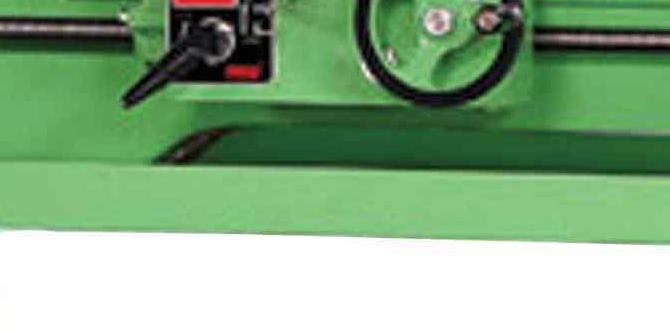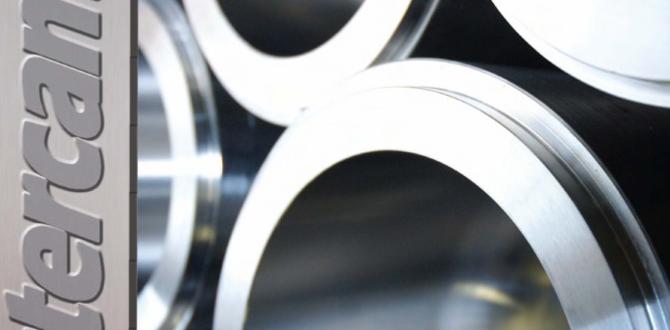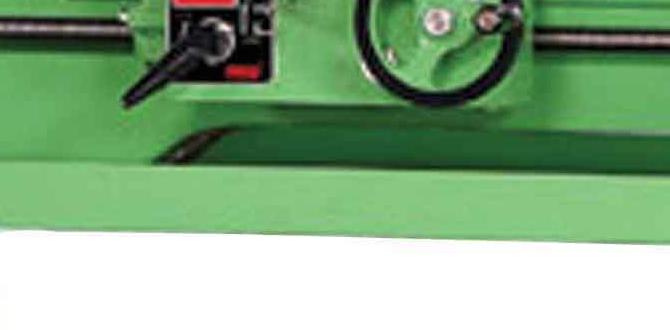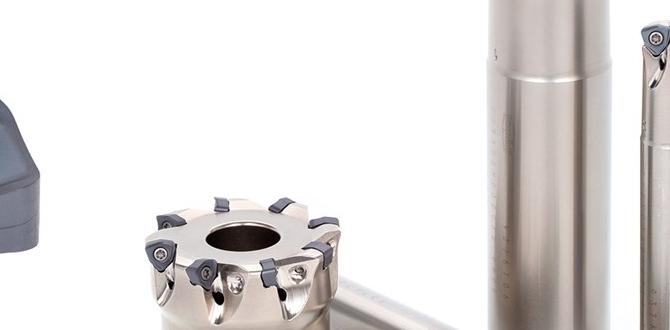Choosing the right wood lathe tool steel is crucial for smooth cuts, extended sharpness, and a safer turning experience. High-speed steel (HSS) is best for beginners due to its durability and ease of sharpening, while carbide offers extreme longevity for production work but requires specialized sharpening. Understanding the differences helps you select the ideal steel for your projects and skill level.
Ever found yourself battling a wood lathe tool that just won’t cut cleanly? It’s a common frustration, especially when you’re starting out or trying to tackle a new type of wood. The culprit often isn’t your technique, but the steel your tools are made from. Different steels have unique properties that affect how they perform, how long they stay sharp, and how easy they are to maintain. Picking the right one can transform your woodworking experience from a struggle into a joy. In this guide, we’ll break down the essential wood lathe tool steel types, what makes them tick, and how to choose the best for your needs. Get ready to turn with confidence!
Understanding Wood Lathe Tool Steel: What Matters Most?
When you’re selecting tools for your wood lathe, the material of the cutting edge is paramount. It dictates how the tool behaves and how much effort you’ll need to put into maintaining it. We’re going to look at the key characteristics that differentiate various tool steels. Understanding these will empower you to make smarter choices for your workshop.
Hardness
Hardness is a measure of a material’s resistance to indentation or scratching. For lathe tools, a harder steel will hold a sharper edge for longer. Think of it like trying to dent a marble versus a piece of chalk. The marble is much harder and will resist damage. However, extreme hardness can sometimes lead to brittleness, meaning the edge might chip if subjected to shock or excessive force.
Toughness
Toughness is the ability of a material to absorb energy and deform plastically without fracturing. For wood turning, this is vital. A tough steel can withstand the impacts and vibrations inherent in turning wood, especially denser species or when encountering knots. If a steel is very hard but not tough, its edge might be prone to chipping or breaking during use, even if it stays sharp for a while.
Wear Resistance
Wear resistance refers to how well a steel can withstand abrasion and erosion from contact with the material being cut. Woods contain abrasive elements, and the friction generated during turning causes wear on the tool’s edge. Steels with high wear resistance will maintain their sharpness for a much longer period before needing to be resharpened.
Ease of Sharpening
While we all want tools that stay sharp, the ability to resharpen them when they do dull is just as important. Some incredibly hard steels can be very difficult to sharpen, requiring specialized grinding wheels or techniques. For beginners and even many intermediate woodturners, an easier-to-sharpen steel is often more practical. It means less time spent at the grinder and more time at the lathe.
The Main Contenders: High-Speed Steel (HSS) vs. Carbide
When you look at modern wood lathe tools, you’ll primarily encounter two types of cutting materials: High-Speed Steel (HSS) and Carbide. Each has its distinct advantages and disadvantages, making them suitable for different users and applications.
High-Speed Steel (HSS)
HSS has been the traditional material of choice for wood lathe tools for decades, and for good reason. It offers a fantastic balance of properties that make it incredibly versatile and user-friendly.
What is HSS?
High-Speed Steel is a category of tool steels that are designed to resist “softening” and deforming at high temperatures generated by friction during cutting. They contain alloying elements like tungsten, molybdenum, chromium, and vanadium. These elements enhance hardness, toughness, and wear resistance.
Pros of HSS Tools
- Excellent Balance of Hardness and Toughness: HSS strikes a good compromise. It’s hard enough to hold a keen edge for general turning but tough enough to resist chipping, even when you’re pushing the tool a bit.
- Ease of Sharpening: This is a major advantage for many woodturners. HSS can be effectively sharpened on standard grinding wheels (often 180 or 360 grit) and honing stones. This means you can maintain a razor-sharp edge with relatively common workshop equipment.
- Good Value: HSS tools generally offer excellent performance for their price, making them an accessible option for beginners and hobbyists.
- Versatility: They perform well on a wide range of woods, from soft pines to hardwoods.
Cons of HSS Tools
- Will Dull Over Time: Compared to carbide, HSS edges will dull more quickly, especially when cutting abrasive woods or working at higher speeds. This means more frequent sharpening is required.
- Can Overheat if Sharpened Improperly: If you bring an HSS tool to a dull red or blue color on the grinder, you can anneal it, making the edge soft and useless.
Common HSS Grades
While there are many HSS grades, for woodturning tools, you’ll most commonly see:
- M2 (AISI M2): This is a very common and well-rounded HSS grade. It offers a good blend of hardness, toughness, and wear resistance, making it an excellent choice for general-purpose wood lathe chisels.
- M42: This grade contains a higher percentage of cobalt, which significantly increases its hardness and red-hardness (its ability to retain hardness at higher temperatures). M42 tools will hold an edge longer than M2 but can be slightly more brittle and more difficult to sharpen. For demanding turning or very abrasive woods, M42 is a superb option if you have the sharpening resources.
For beginners, starting with M2 HSS tools is highly recommended. They are forgiving, easy to maintain, and offer great performance.
Carbide
Carbide, specifically Tungsten Carbide, has revolutionized many cutting industries, and woodturning is no exception. Carbide inserts offer a different approach to tooling by using disposable or replaceable cutting tips.
What is Tungsten Carbide?
Tungsten carbide is an inorganic chemical compound. It’s an extremely hard material, often second only to diamond in hardness. It’s usually manufactured into small inserts or tips that are attached to a tool handle. These inserts are made by sintering tungsten carbide powder with a binder, typically cobalt, under high heat and pressure.
Pros of Carbide Tools
- Exceptional Edge Retention: Carbide’s extreme hardness means it can retain a sharp cutting edge for incredibly long periods, often hundreds of times longer than HSS. This makes it ideal for production work or for turners who dislike frequent sharpening.
- Cuts Tough and Exotic Woods with Ease: Due to its hardness and wear resistance, carbide excels at cutting abrasive materials like lignum vitae, ebony, or even stabilized woods that quickly dull HSS.
- No Traditional Sharpening Needed: Instead of grinding, when a carbide insert dulls, you typically rotate it to a fresh edge (if it has multiple) or replace it entirely. This appeals to those who find grinding intimidating.
- Consistent Geometry: Because the inserts are manufactured precisely, they offer a uniform cutting profile every time.
Cons of Carbide Tools
- Brittle: Carbide is very hard but also quite brittle. It can chip or shatter if dropped, subjected to heavy impact, or used to pry at the wood. The cutting edge can be prone to micro-chipping if not used correctly.
- Difficult to Sharpen (if at all): While you don’t “sharpen” carbide in the traditional sense, regrinding a chipped or worn carbide insert requires specialized diamond grinding wheels, which are expensive and not part of a typical woodshop setup. For most users, replacement is the solution.
- Cost: Carbide tools and replacement inserts can be more expensive upfront than HSS tools.
- Requires Specific Techniques: Carbide tools are designed to shear cleanly. They are generally not used for scraping in the same way traditional HSS gouges might be. Incorrect use can lead to chipping.
Types of Carbide Inserts
Carbide tools often come with different insert shapes and edge geometries:
- Round: Great for hollowing, coves, and general shaping. They are very forgiving.
- Square: Offer a sharper corner for detail work and scraping-like action.
- Diamond/Patented Shapes: Designed for specific tasks like fine detail, tenon removal, or undercutting.
For beginners, a round carbide insert tool can be a good introduction to the benefits of carbide, as they are quite robust and easy to use for basic shaping.
Other Tool Steel Possibilities (Less Common for Lathe Tools)
While HSS and carbide dominate the market for wood lathe cutting tools, you might encounter other steel types in specific contexts or in older tools. Understanding these can offer additional perspective.
Carbon Steel
Historically, many woodworking chisels and planes were made from carbon steel. These steels are relatively simple iron-carbon alloys. They can be hardened to a significant degree and are generally easy to sharpen to a very fine edge.
Why it’s less common for wood lathes:
- Lower Red-Hardness: Carbon steel loses its temper (hardness) at much lower temperatures than HSS. The heat generated by turning wood can quickly soften a carbon steel edge.
- Lower Wear Resistance: Compared to HSS or carbide, carbon steel dulls much faster.
- Prone to Rust: Most high-quality carbon steels are susceptible to rust if not meticulously maintained.
While you might find vintage carbon steel lathe tools, HSS is a vast improvement for modern woodturning.
Powder Metallurgy (PM) Steels
These are advanced steels made through a powder metallurgy process. The fine powder is compacted and sintered, allowing for very homogeneous microstructures and the ability to create alloys with high amounts of alloying elements that would be difficult or impossible to achieve with traditional melting and forging. Examples include CPM 10V or D2 (though D2 is more common for knives).
Why it’s less common for wood lathes:
- Cost: PM steels are generally more expensive.
- Sharpening Difficulty: Due to their high alloy content and fine grain structure, they can be very abrasive to grind and require specific techniques or diamond abrasives.
- Overkill for Most Woodturning: While offering exceptional toughness and wear resistance, their benefits might be overkill for the average woodturner and harder to leverage effectively.
Comparing Steel Properties: A Quick Table
To help visualize the differences, here’s a table summarizing the key properties:
| Property | High-Speed Steel (HSS) | Tungsten Carbide | Carbon Steel |
|---|---|---|---|
| Hardness | High | Very High (Near Diamond) | Medium to High |
| Toughness | Good | Low (Brittle) | Medium |
| Wear Resistance | Good | Excellent | Fair |
| Ease of Sharpening | Easy to Moderate | Difficult (Requires Diamond) / Replaceable | Easy |
| Heat Resistance (Red-Hardness) | Good | Excellent | Poor |
| Typical Use on Lathe | All-purpose chisels & gouges | Replaceable inserts for various tools | Vintage tools, not recommended for modern use |
Choosing the Right Tool Steel for You
Now that we know the materials, how do you decide what’s best for your workshop and your turning style? Consider these factors:
For the Absolute Beginner
If you’re just getting started with a wood lathe, HSS tools are almost always the best choice. Here’s why:
- Forgiving: They are less prone to catastrophic failure (like chipping or breaking) than carbide if you make a minor mistake.
- Easy to Maintain: You can learn to sharpen them effectively with basic equipment, which is a fundamental skill for any woodworker.
- Cost-Effective: A good set of HSS tools won’t break the bank, allowing you to invest in other essentials.
Look for tools made from M2 HSS. They offer a great balance and are readily available from reputable manufacturers.
For the Hobbyist/Intermediate Turner
As you gain experience and tackle more challenging projects, you have more options. Many intermediate turners continue to use HSS, perhaps moving to M42 for better edge retention on harder woods. Others start integrating carbide tools into their arsenal.
- HSS (M2/M42): Excellent for general turning, bowls, spindles, and even faceplate work. Learn to sharpen them well, and you’ll be set.
- Carbide (Round Inserts): A good entry into carbide. A simple round carbide tool can handle much of your basic shaping, deburring, and can be very efficient on coves. They require minimal setup and learning curve for basic use.
For the Advanced/Production Turner
If you’re turning for extended periods, working with very hard or abrasive woods, or producing items in volume, carbide tools often make the most sense.
- Carbide Tools (Various Shapes): Investing in a set of carbide tools with different insert shapes (round, square, diamond) can significantly speed up your workflow and reduce downtime associated with tool maintenance. The consistent edge and durability are invaluable for high-volume production.
- Specialty HSS: Some very advanced users might still prefer highly specialized HSS alloys or techniques for specific tasks where the unique properties of HSS are advantageous.
Essential Tool Care and Sharpening Tips
No matter which steel you choose, proper care and sharpening are key to getting the best performance from your tools. Here are some fundamental tips:
Sharpening HSS
The goal is to restore a keen edge without overheating the steel. You want to remove just enough metal to create a fresh, sharp bevel.
- Use Appropriate Grits: Start with a medium grit wheel (180-360) for establishing the bevel and then move to a finer grit (600+) for a smoother edge. A diamond plate or ceramic honing rod can be used for final honing.
- Employ a Jig: Using a tool rest or a dedicated sharpening jig ensures a consistent angle for your bevel, which is crucial for good performance. Many lathe tool manufacturers offer specific jigs for their tools.
- Keep the Steel Cool: Dip your tools in water frequently during grinding to prevent the edge from overheating and losing its temper. Avoid prolonged contact with the grinding wheel.
- Hone Regularly: A few passes on a fine stone or honing steel after a turning session can extend the life of the edge between grinds.
Reference resources like WoodTurners Anonymous‘s sharpening guides can provide more in-depth instruction.
Maintaining Carbide Tools
Carbide doesn’t require grinding, but it does need care.
- Handle with Care: Store carbide tools so the inserts don’t bang against other tools or surfaces. A dropped carbide tool is very likely to chip or break.
- Rotate or Replace Inserts: When the cutting edge becomes dull or chipped, rotate a new edge into place if available. If all edges are dull or damaged, replace the insert.
- Keep Them Clean: Wipe down the tool body and inserts after use to prevent dust and debris from accumulating.
Safety First: Always Consider Tool Steel Properties
The type of steel your tool is made from directly impacts safety. Always remember:
- Sharp Tools Cut Safely: A sharp HSS or carbide tool will cut wood cleanly and predictably. A dull tool will require more force, making it more likely to catch and cause kickback or injury.
- Understand Brittleness: Be aware that carbide is brittle. Never use a carbide tool to pry, lever, or dig into wood in a way that could cause excessive shock or stress to the edge.
- Proper Sharpening Prevents Overheating: Improperly grinding HSS can lead to overheating, ruining the temper of the steel and creating a dangerously soft edge that can deform or break unexpectedly.
- Secure Your Tools: Ensure that any replaceable carbide inserts are securely







